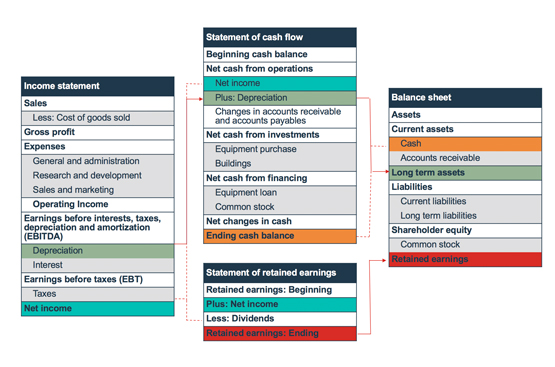How to account for assets and expenses in your start-up
4-minute read
Understanding your finances while building your start-up can be overwhelming. Books are often out-of-date or inaccurate. Worries about running out of cash can keep you up at night.
But learning about your finances isn’t as hard as you might think. Most of all, it can save you money and help you make better business decisions.
“Many entrepreneurs don’t feel comfortable with financial numbers,” says Alexandre Leclerc, Director, Growth and Transition Capital at BDC, who worked with a lot of technology businesses. “But ignoring the books makes you vulnerable to cash emergencies. You may not realize that you’re in a deficit until it’s too late.”
Your financial statements contain early warning sign about the financial health of your business. Here are three key financial documents you need to understand to ensure the sustainability of your start-up.
1. Income statement
Sometimes called a profit-and-loss statement, the income statement tells you how much money you’re making and spending. It’s typically prepared on a monthly or quarterly basis.
To calculate your gross profit, you add up all your income and then subtract your direct costs (known as “cost of goods sold” for manufacturers, or “cost of sales” for retailers and wholesalers). Direct costs are those connected directly to making a product or offering a service, such as labour and raw materials.
Using your gross profit, you can calculate your operating income—also known as earnings before interest and taxes (EBIT). To do so, you take the gross profit and subtract overhead expenses related to running the business, such as office salaries, marketing, rent and insurance.
To calculate your net income, subtract interest, taxes, depreciation and amortization from your operating income.
2. Balance sheet
Your balance sheet tells you how much you own and what you owe. On the assets side are your short-term or “current” assets (cash, accounts receivable, inventory, prepaid expenses), plus long-term or “fixed” assets (vehicles, equipment, land and buildings, investments, patents and goodwill, etc.)
On the liabilities and shareholders’ equity side are also two subcategories: short-term or “current” liabilities (accounts payable, credit card debt, operating credit, accrued expenses, taxes payable, the current portion of your long-term debt, etc.) and longer-term liabilities, such as term loans.
Shareholders’ equity represents the amount of money shareholders have invested into the business through investments and the cumulative profits you have reinvested in your business via retained earnings.
The sum of yours assets will always equal the sum of your liabilities and shareholders’ equity.
3. Cash flow projections
Projections are another important financial tool. They’re a way of seeing into the future to predict your cash flow ebbs and flows. The idea is to try to anticipate cash flow squeezes and plan ahead to avoid them. A cash flow projection can help you time your spending decisions, arrange working capital financing to tide you over any upcoming rough patches and give you peace of mind.
The figure below shows you how these various financial documents work together.
Check your statements regularly
Many business owners make the mistake of ignoring their financial numbers or updating them infrequently. “The more often you check and update your books, the sooner you’ll catch any problems with your cash position or profitability,” Leclerc says. Try to update your financial statements monthly.
Make the most of accounting software
Accounting software gives you many tools to track financial information. Free and low-cost software packages can allow you to register sales, do invoicing, monitor accounts payable and receivable, create budgets, produce reports, set payment alerts and prepare financial statements.
It’s important to configure the software to suit your business, not just run it with its default settings. For example, you can customize invoice forms, dashboards and expense categories.
Get help
It’s a good idea to ask a bookkeeper or accountant to regularly review your books to make sure you’re recording everything properly. This is best done at least quarterly.
For example, many businesses fail to amortize long-term purchases over the asset’s lifespan, leading to an inaccurate balance sheet. It’s also common for businesses to mistakenly record inventory under cost of goods sold.
While an external accountant may review your books once a year, this may not be enough if you want to monitory your profitability more frequently.
You can ask your bookkeeper or accountant to walk you through the numbers so you understand them better. “Investing in your financial education can pay off significantly for your business,” Leclerc says.
To make sure you're up to date on this important topic, check out our article on Accounting Basics or download our free guide: Understanding Your Financial Statements.

